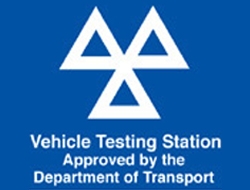MOT Testing
Between the two garage at Spennymoor and Coxhoe we have 5 fully qualified MOT testers.
As a fully registered and licensed MOT testing centre by VOSA (Vehicle & Operator Services Agency), we are able to offer a comprehensive and professional service.
An annual MOT test is a legal requirement for any vehicle over three years old. The MOT test is designed to ensure that all vehicles driven on the roads meet the minimum safety and environmental standards required by law at the time of testing.
It does not mean that the vehicle is roadworthy for the length of time the certificate is valid and the MOT certificate is no guarantee of the mechanical condition of the vehicle. As an official MOT centre we are authorised to provide MOT testing for vehicles of class 1,2 and 4 by the Vehicle and Operator Services Agency (VOSA). Essentially that means that we are authorised to perform an MOT check on cars and light vans.
During the MOT test one of our VOSA approved MOT testers will conduct a comprehensive MOT inspection and a series of checks to your car both internally and externally. The main checks are:
- Body and Vehicle Structure
- Fuel System
- Exhaust System and Emissions
- Seat and Seat Belts
- Doors
- Mirrors
- Mirrors
- Load Security
- Brakes
- Tyres and Wheels
- Registration Plates
- Vehicle Identification Number (VIN)
- Lights and Signals
- The Bonnet
- Windscreen, Wipers and Washers
- The Horn
- Steering and Suspension
Help with your MOT
35% of MOT's fail first time, and far too many are due to an avoidable reason. Here are some simple checks to do before bringing your vehicle in for its MOT;
- 19% Fail due to lights not working
- 18% Fail due to poor handbrake efficiency
- 30% Fail on the poor condition of tyres
New mandatory test items from 2012
If you've been happily ignoring a warning light because it's not checked in the MOT you could be facing an MOT failure and an expensive repair bill in 2012 because of changes to the test. The Department for Transport is adding a number of new mandatory test items to the annual MOT from 1 January 2012 to comply with a revised European testing directive. The aim of the revised directive (2009/40/EC) is to harmonise minimum test requirements across Europe and make sure the test reflects the electrical/electronic complexity of modern car safety features.
VOSA, the government agency responsible for the MOT, has indicated that 'failures' relating to the new test items will be treated as 'advisories' in the first three months. This means that if you have any of the following problems with your car you've got until the first MOT renewal date after 1 April 2012 to get it fixed.
The main changes from 2012
Electronic Parking Brake
Electronic parking brake controls are now included and must be present and not inappropriately repaired or modified - repair obviously likely to adversely affect the roadworthiness of the vehicle or modification that has seriously weakened the component.
(The 'inappropriately repaired or modified' check is to be applied to a wide range of systems and components throughout the vehicle.)
The car will fail if an Electronic Parking Brake warning lamp is illuminated to indicate a malfunction.
Electronic Stability Control
Checks of anti-lock brakes will be extended to include Electronic Stability Control if fitted. The tester will check for the presence and correct operation of the ESC malfunction warning light together with looking for obviously missing, excessively damaged or inappropriately repaired or modified components and electrical wiring, as well as an ESC switch missing, insecure or faulty.
Warning Lights
As well as electronic parking brake and electronic stability control warning lights (where fitted) the MOT test will also include checks for the correct function of the following, where fitted;
- Headlight main beam warning light
- Electronic power steering warning light
- Brake fluid level warning light
- Tyre pressure monitoring system warning light
- Air bag warning light
- Seat belt pre-tensioner warning light
Steering and Suspension
The new test includes a check on the presence and correct function of the steering lock where fitted as standard.
Missing, or split/damaged dust covers on steering and suspension ball-joints will result in failure if they will allow dirt to enter the joint.
Power steering fluid level must be above the minimum level indicated on the reservoir.
Lighting
Products on the lens or light source that obviously reduce the light's intensity or change its colour will become a reason for failure - applies to front/rear position lamps, registration plate lamps, stop lamps, rear fog and direction indicators.
Headlight requirements are updated to take account of the particular characteristics of High Intensity Discharge (HID) lamps.
HID headlights can cause dazzle if they are dirty or aimed too high so car manufacturers must fit headlamp cleaning and levelling systems. Where HID or LED dipped beam headlamps are fitted the tester will switch on the headlamps and check the operation of any headlamp levelling and cleaning devices fitted.
The car will fail if a headlamp levelling or cleaning device is inoperative or otherwise obviously defective.
If a headlamp bulb is not seated correctly the resulting beam pattern will be indistinct and this will result in a test fail.
Electrical Wiring and Battery
An insecure battery will be a reason for failure as will a battery that is leaking electrolyte.
Visible wiring that is insecure, inadequately supported or likely to cause a short will also result in a failure as will wires bared by damaged insulation.
Trailer/caravan Electrical Socket
There will be a basic security/damage check of 7-pin sockets, 13-pin sockets will be subject to a full electrical connectivity check and incorrectly connected or inoperative circuits will result in failure.
Tyres
Tyre pressure monitoring systems fitted to vehicles first registered after 1 January 2012 must be working correctly and not indicating a malfunction.
Supplementary Restraints
The vehicle will fail the test if any air bag fitted as original equipment is obviously missing or defective.
A seatbelt pre-tensioner fitted as original equipment but missing or that has obviously deployed will be a reason for failure.
Seatbelt load limiters that are missing where fitted as standard or folding webbing type limiters that have obviously deployed are also reasons for failure.
The vehicle will also fail if an SRS malfunction light is missing, not working or indicating a fault.
Speedometer
The car will fail if a speedometer is not fitted, is incomplete, inoperative, has a dial glass broken/missing or cannot be illuminated.
Seats
It must be possible to secure the driver's seat fore and aft adjustment mechanism in two or three different positions. On electric seats the motors must move the seat fore and aft.
Doors
A rear door that cannot be opened from the outside using the relevant control is a new reason for failure.
Doors must be easy to open and close - hinges, catches and pillars will be inspected.
Towbars
Inappropriate repair or modification to the towbar assembly will be a reason for failure if judged likely to affect the roadworthiness of the vehicle/trailer.
Exhaust
A catalytic converter fitted as original equipment but missing will be a reason for failure.
Fuel System
Damaged or chaffed fuel pipes will result in failure.



